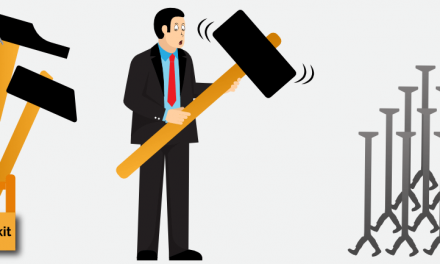Innovation is a hot topic nowadays. Many organizations are investing in some form of innovation lab or internal accelerator program. Or they separate new business ventures from the main organization by starting a startup-like small company. Or acquire one for that matter. Many are experimenting with concepts like lean startup, business model innovation, or design thinking to give their innovation powers a boost. What these companies have in common is they realize their business models won’t last forever. What they also seem to have in common most often is the idea you can successfully externalize innovation from the rest of your organization. This seems to tag along with the idea you only need to innovate once (successfully) to be safe for a while again. But is this true?
What can you expect from this article?
- Learn why innovation needs to be continuous and what that means
- Learn why externalization of innovation might not be the best strategy in the long run
The world has changed
 Most decision makers agree their business models are or will be under pressure. They need some form of innovation. Yet there are plenty of examples that illustrate how hard it is to innovate in time. Upon introducing the iPhone, RIM’s CEO Jim Balsillie, told a Reuters reporter that the launch of Apple’s iPhone wasn’t a major threat, simply the entry of yet another competitor into the smartphone market.1 We all know how that ended. Toys ‘R’ US always seemed like a rock solid name to me. I didn’t even realize the company dated back to the fifties. Yet, the company filed for bankruptcy in September 2017. RadioShack was a household name for decades in the US after it filed for bankruptcy for the second time in 2017. What these companies have in common is that they were once highly successful, but didn’t manage to turn the ship around fast enough to survive or stay relevant.
Most decision makers agree their business models are or will be under pressure. They need some form of innovation. Yet there are plenty of examples that illustrate how hard it is to innovate in time. Upon introducing the iPhone, RIM’s CEO Jim Balsillie, told a Reuters reporter that the launch of Apple’s iPhone wasn’t a major threat, simply the entry of yet another competitor into the smartphone market.1 We all know how that ended. Toys ‘R’ US always seemed like a rock solid name to me. I didn’t even realize the company dated back to the fifties. Yet, the company filed for bankruptcy in September 2017. RadioShack was a household name for decades in the US after it filed for bankruptcy for the second time in 2017. What these companies have in common is that they were once highly successful, but didn’t manage to turn the ship around fast enough to survive or stay relevant.
Why Continuous Innovation
“Continuous innovation makes sense when the life-cycle of a business model is either short, or unpredictable. Or both.”
Lowered barriers of entry
Continuous innovation only makes sense if the life-cycle of a business model is either short, or unpredictable. Or both. We argue this is the case in most industries nowadays. Let’s investigate why. One of the major reasons is that barriers of entry for newcomers are dramatically lowered:
The access to information and knowledge is now almost equal for anyone. Protecting a market by superior knowledge once was a standard way to protect your competitive advantage.
Access to talent is easier. People can work everywhere nowadays, we don’t necessarily have to gather in the same office building everyday anymore.
Capital is more easily obtainable. Although investment funds seem to have raised the bar lately, there are still many accelerator programs, startup boot camps, and corporate incubator programs. Angel investors are a valid option for many, and crowd-funding platforms are still growing.
Access to capital is not only easier, companies typically also need less of it to start. Launching a product or service, especially online, has never been faster and cheaper.
According to Ash Maurya you can launch and grow a business from anywhere these days. Geographic borders are down. Even more, you can be a global player too. As Hal Varian, Chief Economist at Google, puts it2:
“If the late 20th Century was the age of the multinational company, the early 21st will be the age of the micro-multinationals: small companies that operate globally.”
A sustainable competitive advantage no longer exists
The competitive landscape has been majorly disrupted because of the lowered barriers of entry. However, most companies are designed to defend their business models over a long period of time. They are designed to squeeze the last bit of efficiency out of a business model before giving up. As a result they are ill equipped for fast and repeated innovation. This explains the popularity of organizing innovation away from the core of the organization, shielding it from the slow bureaucracy of the organization. There is an even more profound and important consequence that business leaders need to understand and accept in order to have a decent chance to lead their organizations to long-term success:
“A sustainable competitive advantage no longer exists.”

“When competitive advantages don’t last, or last for a much shorter time than they used to, the strategy playbook needs to change.”
“The Adaptive Organization has the core ability to continuously reinvent itself.”
Although it is applaudable that companies take initiative in innovation programs, I am afraid that the current prevailing strategy of externalizing it, will bring disappointing results in the long run. It also feels like senior management is not all in: they still bank on the current main organization, and innovation is still a separate show that can easily be canceled once its popularity starts fading. Let’s finish with a quote of the famous Peter Drucker:
“Because the purpose of business is to create a customer, the business enterprise has two–and only two–basic functions: marketing and innovation”
Conclusion
Many once important and profitable companies have died because they did not reinvent themselves in time. Dramatically lowered barriers of entry have changed the competitive landscape which calls for a strategy of continuous innovation. As a consequence we have to realize that a long-term sustainable competitive advantage no longer exists. Yet, most companies are still designed to defend one.
Organizations need a more structural aproach to continuous innovation that supports the ability to continuously reinvent themselves, which is in contrast with the current aproach of exernalizing innovation in the form of corporate startups, internal incubator programs, multispeed strategy, etc.
Bibliography
List of notes and sources we reference from.
Notes
- Dabrowski, W. (2007). “Update 1-RIM Co-CEO doesn’t see threat from Apple’s iPhone”. Reuters
- Hal Varian (2011). Micro-multinationals will run the world. http://foreignpolicy.com/2011/08/15/micromultinationals-will-run-the-world/]
- McGrath, Rita Gunther. (2013). The end of competitive advantage. Harvard Business Review Press. p. 4.]
Follow this article
You can choose to follow this article in which case you will be notified when there there are updates of the article. You can also choose to follow all articles of this category. You will then be notified if a new article is added in this category.





